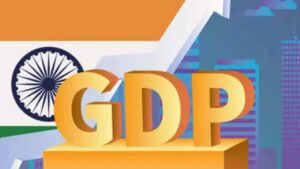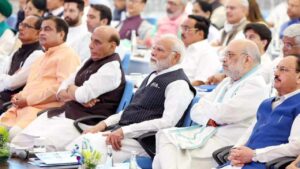
Introduction
India, the world’s fastest-growing major economy, has recently experienced a concerning trend: a noticeable slowdown in private consumption during the fourth quarter of the financial year 2024-25 (Q4 FY25). While macroeconomic indicators have largely remained stable and inflation appears under control, the slowing pace of household spending has raised alarms among policymakers and economists alike. This article delves deep into the underlying reasons for this consumption drag, the concept of financial deficiency, and its potential impact on the broader Indian economy.
Keywords: Indian economy consumption trends, Financial deficiency in India, India household spending 2025, Q4 FY25 private consumption slowdown
Q4 FY25 private consumption slowdown
Overview of Q4 FY25 Economic Performance:Q4 FY25 private consumption slowdown
Before analyzing the slowdown in private consumption, it is essential to understand the broader context of Q4 FY25. According to preliminary data released by the Ministry of Finance and the Reserve Bank of India (RBI), India’s GDP growth in Q4 FY25 was estimated at 5.8%, lower than the 6.6% posted in Q3 FY25 and well below the optimistic projections of over 7% made earlier in the year.
A closer look at sectoral growth shows that agriculture and allied sectors faced stress due to erratic monsoons, manufacturing saw moderate growth, and services—especially contact-intensive segments—remained strong but showed signs of plateauing. However, the most worrying indicator was the contribution of private final consumption expenditure (PFCE) to overall GDP growth, which fell from 55% in Q3 to around 51% in Q4.
Understanding Private Consumption and Its Significance
Private consumption refers to the total spending by households on goods and services. In India, this component accounts for nearly 58-60% of the GDP, making it a critical engine of economic growth. Any sustained slowdown in this metric has a ripple effect across industries—ranging from fast-moving consumer goods (FMCG) and automobiles to retail, housing, and financial services.
A slowdown in private consumption, therefore, reflects a deeper malaise. It either means households are earning less, saving more out of precaution, or facing liquidity constraints due to debt or inflation. Each of these outcomes carries unique implications for policy and growth.
Causes of the Consumption Slowdown in Q4 FY25
-
Income Stagnation While nominal wages have risen, real income (adjusted for inflation) has stagnated for large sections of the population. Rural wages have particularly been under pressure. According to CMIE data, rural wage growth was under 3% YoY in Q4 FY25, while inflation hovered around 5%, effectively eroding purchasing power.
-
Persistent Urban-Rural Divide Urban consumption remained relatively resilient, driven by digital commerce and premium product segments. However, rural demand, which constitutes nearly 40% of FMCG consumption, showed weakness. Declining farm incomes, increased indebtedness, and weaker government transfers all contributed to the slump.
-
High Inflation in Essentials Though headline inflation is within RBI’s tolerance band, core essentials such as food, fuel, and healthcare saw price spikes. This led households to prioritize basic necessities over discretionary spending, dampening overall demand.
-
Rising Indebtedness Easy credit policies in the previous quarters led to a spike in household debt. By Q4 FY25, loan servicing burdens increased, especially for middle- and lower-income households. EMIs for home, education, and consumer loans reduced disposable income for non-essential purchases.
-
Employment Concerns While the unemployment rate officially remained at 7.1%, underemployment and informal sector distress continued. The gig economy, which once seemed to offer resilience, showed saturation, particularly in urban delivery services and ride-sharing platforms.
-
Policy Uncertainty The interim Union Budget 2025 lacked bold consumption-boosting measures. While capital expenditure commitments were upheld, direct support to households was limited. GST reforms and direct tax changes also failed to deliver immediate relief.
Financial deficiency in India
What is Financial Deficiency? Financial deficiency in India

Financial deficiency, in this context, refers to a state where households and small businesses face persistent cash flow constraints, reducing their ability to participate in economic activities meaningfully. It can arise due to:
-
Lack of income growth
-
High debt burden
-
Insufficient financial inclusion
-
Unstable job opportunities
-
Reduced government support programs
In Q4 FY25, all these factors converged. Surveys indicate that savings have been depleted for a significant portion of low-income families post-pandemic. Many households now operate on thin margins, where even minor shocks—medical expenses, price hikes, or job losses—can tip them into financial distress.
India household spending 2025
Sectoral Impact of Slowing Private Consumption :

-
Automobiles Passenger vehicle sales grew marginally by 3% YoY in Q4 FY25, down from double-digit growth in FY24. Two-wheeler sales—a proxy for rural demand—contracted 4.5% YoY.
-
FMCG Volume growth in the FMCG sector slowed to 2% in Q4 FY25, down from 7% in Q3. While premium brands showed some resilience, mass-market products saw lower uptake.
-
Retail and E-commerce Offline retail footfalls dropped by 5% QoQ, while online sales remained stable, indicating value-conscious buying. Festive season sales failed to meet expectations, especially in Tier-II and Tier-III cities.
-
Housing Affordable housing demand shrank due to higher interest rates and tighter lending norms. Meanwhile, luxury and mid-segment real estate remained buoyant in metros, highlighting the K-shaped recovery.
-
Consumer Durables Sales of white goods and electronics were tepid. Demand for entry-level and mid-range appliances fell, while premium offerings remained relatively unaffected.
Government and RBI Response
In response to the slowdown, both the government and the RBI have signaled accommodative measures. The RBI, in its June policy meeting, maintained the repo rate at 6.5% but hinted at potential rate cuts if inflation remains under control.
The government, on the other hand, has explored targeted subsidy rationalization and expanded credit support under schemes like PM SVANidhi and MUDRA. However, critics argue that these are insufficient to spur large-scale consumption.
The Way Forward: Policy Recommendations
-
Direct Income Support Programs like PM-KISAN need expansion and realignment to ensure timely and adequate support to rural households.
-
Wage Growth Initiatives Linking rural employment schemes with skill development and microenterprise support can boost incomes and job stability.
-
Credit Discipline and Financial Literacy Households need better awareness of debt management. Regulatory oversight on personal loans and BNPL (Buy Now Pay Later) schemes is essential to prevent overleveraging.
-
Tax Relief for Middle Class A review of income tax slabs and increased standard deductions can improve disposable income.
-
Revamp Public Distribution and Health Systems Strengthening PDS and ensuring affordable healthcare can reduce financial shocks and allow for higher discretionary spending.
Conclusion
The Q4 FY25 slowdown in private consumption is a symptom of broader financial deficiency among Indian households. While macroeconomic fundamentals appear stable, the microeconomic reality reveals stress among consumers who are critical to sustaining demand-led growth. It is essential for policymakers, industry leaders, and financial institutions to recognize this fragility and act decisively.
India’s growth story hinges not just on infrastructure and exports but also on the vibrancy of its internal market. A revival in private consumption will not occur organically; it requires strategic interventions and a holistic understanding of the financial ecosystems of common citizens. Only then can India reclaim and sustain its growth momentum in the years ahead.
